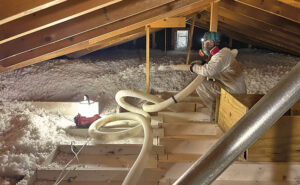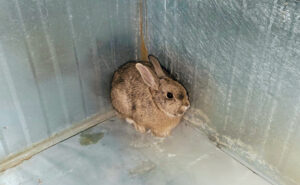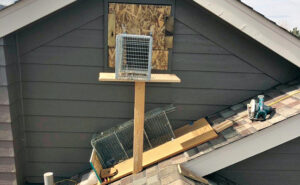
A Whitmore Pest & Wildlife Control restoration technician replaces the old attic insulation that was removed with new, more energy-efficient insulation. (PHOTO: WHITMORE PEST & WILDLIFE CONTROL)
In the competitive world of pest control, diversifying services can significantly boost your business’ growth and customer satisfaction. One effective way to achieve this is by incorporating nuisance wildlife control and restoration services. There is no shortage of factors to consider when offering these services, so the following essential tips are designed to help you successfully expand your offerings.

This rabbit turned up where it didn’t belong: inside a furnace cold-air return. (PHOTO: WHITMORE PEST & WILDLIFE CONTROL)
Understanding nuisance wildlife control
Nuisance wildlife control involves managing and mitigating the presence of wild animals that cause problems for homeowners and businesses. While some pest control companies prefer to refer this service to a wildlife specialist, if you want to bring it in-house, consider taking the following steps:
- Assess the demand and scope in your market. Identify common wildlife issues and tailor your services to meet these needs. Consider wildlife licensing and regulations in the states in which you operate.
- Decide what “wildlife” means to your company, based on market demand and your team’s expertise. Focus on the types of wildlife control your team can perform exceptionally well and align with your core competencies. From bats to snakes, raccoons to squirrels, and lots of critters in-between, each animal presents unique challenges and requires specific knowledge and techniques for effective control.You may find it wise to focus on certain types of wildlife to begin with and look at expanding later on, rather than trying to do everything someone calls you about.
- Train and certify. Ensure your team is well-trained and certified in trapping, exclusion methods and understanding wildlife behavior — in addition to soft skills like talking with customers and selling. Proper training not only ensures effective service, but it also builds trust with your customers.
- Use humane practices. That said, there are a lot of different opinions on what is “humane.” Be prepared for this concern from your customers. For example, you can use one-way doors and exclusion devices that allow animals to leave the structure without being able to re-enter. This method can be particularly useful in states where relocation is not permitted, but customers are adamant they do not want the wildlife harmed. As always, every method comes with challenges. Do your best to meet customers where they are and highlight your commitment to humane practices to appeal to environmentally conscious customers.
- Hire and train on exclusion and prevention. A significant part of wildlife control is preventing future intrusions. This involves identifying and sealing entry points, installing barriers, and modifying the habitat to make it less attractive to wildlife. For example, trim tree branches that provide access to roofs or install chimney caps to prevent animal entry. This may necessitate having a designated handyman on staff whose main responsibility is this type of task.
- Educate and communicate. As with any pest control service, be sure to educate your customers about the importance of wildlife control and the steps involved. Clear communication can help set realistic expectations and increase customer satisfaction. Use brochures, your website and social media to provide valuable information about your services and the benefits of wildlife control.
- Integrate technology where appropriate. Enhance your wildlife control services and the customer experience with the use of thermal imaging cameras to detect animals in walls or attics, for example. Some companies use motion sensor cameras to monitor wildlife activity, and some even use drones to inspect hard-to-reach areas. These and other technologies can improve the accuracy and efficiency of your services.
- Update your insurance policy. Ensure your business has the proper insurance coverage, including workers’ compensation and liability insurance. This is crucial for protecting your employees, customers and business from potential risks associated with wildlife control and restoration work. It can be different from the coverage provided for general pest control firms.
- Talk with your lawyer. Have legal counsel review your documentation, terms and conditions. This ensures your contracts and agreements are compliant with local regulations and protect your business interests.
- Hire smart. Screen employees to ensure they can work safely at heights and handle other challenging situations. Work with an occupational health specialist to develop a pre-employment screen and physical to ensure all employees are physically capable of performing their duties safely. The demands required of a wildlife technician can vary significantly from a general pest control technician, so it is worthwhile spending some time optimizing the hiring process.

The Whitmore team sets up a raccoon trap. (PHOTO: WHITMORE PEST & WILDLIFE CONTROL)
Integrating restoration services
Restoration services complement pest control services by addressing the damage caused by wildlife and other pest intrusions. This can include repairing damage to structures, removing contaminated materials, and restoring attics or crawlspaces to their original condition. Let’s take a look at eight basic restoration services, and why they’re important.
- As always, start with a thorough inspection. To assess the scope of the work, check for chewed wires, soiled insulation and other damage to the structure. Provide detailed reports to customers, outlining the necessary repairs and restoration steps. Remember, there is no one-size-fits-all approach.
- Offer attic and crawlspace restoration. This includes cleaning and sanitizing these areas, replacing damaged insulation and repairing structural damage. Proper moisture control in these spaces can prevent mold growth and improve the overall air quality and energy efficiency of the home.
- Offer “home hardening.” This includes more comprehensive repair services, such as fixing damaged roofing, siding and foundations. Addressing these issues promptly can prevent further damage and ensure the safety and integrity of the home.
- Provide contaminant removal services. Contaminants such as pest droppings, urine and nesting materials can pose health risks to customers. Provide thorough contaminant removal and decontamination services to clean and remove risk from the affected areas.
- Assist with insurance claims. Provide customers with detailed reports and documentation of the damage and proposed restoration work. This is not only appreciated by customers, but also can streamline the claims process and help you get larger jobs approved.
- Offer preventive and exclusion services. After restoring the damage, implement measures to avoid future pest intrusions. This can include installing barriers, sealing entry points, and offering maintenance services to monitor and address potential issues. You might already be offering this in your pest control services, but spell it out so your customers understand the value of this added work. It might also be a package tier for those who want to pay more than just “get rid of the pest.”
- Form partnerships with local experts. Have a list of trusted electricians, plumbers, and heating, ventilation and air-conditioning (HVAC) professionals to address any related issues uncovered during the restoration process for which you don’t hold the appropriate licensing — or have simply chosen not to perform in-house. Remember, the quality of work from contractors, whom you’ve suggested to customers, is a reflection on your business, so make sure they’re reputable.
- Always document and be transparent. Provide customers with detailed documentation of the restoration work, including before-and-after photos, reports and warranties. Transparency in your work builds trust and ensures customers are fully informed about the services they received.
Leave A Comment